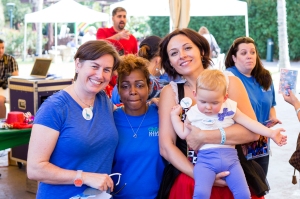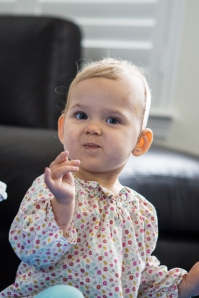A 6-minute video.
How can a 6-minute video video catalyze so much activity?
1:30 into the video I see one process happening in Luna’s brain; the happiness in her eyes melts away while fear and terror are evident as her brain struggles to stop a raging electrical storm.
After a 75 sec complex partial seizure, a separate process is evident: Infantile Spasms which clusters for several minutes.
It is a remarkable video, one that captured her seizure disorder at a very early stage, and before almost all mediation. I am not sure I would have been so insistent Maria continue to seek second opinions after the Norwegian healthcare system more or less gave up on Luna.
If you are unfamiliar with Luna’s story, here is the first post from November 2014. I want to share some of the highlights of her journey in this post.
Nearly 6 months after the onset of Luna’s epilepsy, she received her first 24 hour VEEG. Prior to this, it was only short EEG’s without synchronous video. By this time, courses of steroid and hormone therapy (synthetic ACTH) were tried with some effectiveness, but almost immediate relapse upon completion. Luna was on several conventional anticonvulsants and Sabril.
If they captured the overnight VEEG data before all this intervention, what might be different? Difficult to say, but very interesting to the point of heartbreaking to consider.
MRI impressions were normal and did not correlate with the clinical presentation.
Finally, negative targeted genetic and metabolic testing rendered Luna’s case more or less closed in Norway: etiology unknown.
Take the pills, accept her as she is. She will be disabled, was Maria’s translation of what she was told.
I advised her: Do Not Give Up! I always felt there was hope for Luna.
Why?
Impressions from early EEG tracings found epileptiform discharge activity in both hemispheres, but more in the left hemisphere, and very close to the midline of the brain and almost always with overweight and pre-dominance in the left hemisphere. Often there was bilateral slowing. The slowing was frequently found to a greater extent in the left hemisphere.
To me, the remarkable video was a sign that all the generalized activity could be irrelevant if there was a focus discovered. This theory is difficult to prove given the focal events ceased after the steroid therapy.
An analogy: Imagine if you were spraying water mist or hair spray on your child’s head. And you were standing on their left side spraying towards the head around ear level. As you spray, you move the spray nozzle around, and as you get near the top of their head some of the spray easily falls on the other side of their head. At first, it would be clear that some of the spray from the left side fell on the right side. But if you just never stopped spraying, after a while it is impossible to determine if you sprayed some from the right and some from the left independently, especially if you were brushing the hair during this time.
Maria began looking outside of Norway for help.
Helsinki, Finland has a well-known comprehensive epilepsy treatment facility. Maria engaged the doctors there as did I. Uninterested, they referred her somewhere else in Sweden that was not a good fit for Luna.
2014 began with a trip to Bonn, Germany. The financial cost was high. But, the emotional toll was higher, as once again negative MRI findings ended the investigation despite the presence of a focus in the left hemisphere found in a long-term VEEG.
Dr. Sassen reviewed the early videos and agreed about the focal nature of the episode in the one very remarkable video. Why then did he not recommend more diagnostics?
Luna was weaning steroid therapy during this time and was experiencing seizure control; so no seizures were captured during the VEEG. This lack of clinical seizures was likely to key reason additional diagnostics were not performed.
I remember the defeat in Maria’s words in emails, the misery, and emotional turmoil in the family. Chronic seizure disorders in young children are well-known for disintegrating the family unit. During this period Maria realized she had a marriage built on sand not rock.
By the summer of 2014, Maria was in contact with Dr. Von Allmen and Children’s Memorial Hermann Hospital here in Houston. In parallel, Dr. Simon Harvey from the Royal Children’s Hospital Melbourne, Australia, also reviewed her case.
Dr. Harvey insisted she get a PET scan. In a matter of days, Dr Harvey in Melbourne Australia ordered a PET scan for a child from Norway to be performed at St. Thomas hospital in London, England. You can’t make this up!
The results indicated she should be a good candidate for surgical intervention. Finally, I felt like she broke through an invisible barrier in getting help for Luna.
Where can Luna receive such surgical care?
It wasn’t long before the USA became the only real option and Children’s Memorial Hermann Hospital was the natural selection.
They quoted $125,000.00 for investigation and surgery, far more than anywhere else. But, Luna could get quick access to care here and could not elsewhere.
Maria created a fundraising page through one of the internet-based fundraising sites. The response to Maria’s call for help was dramatic and surprising. God’s plan indeed.
Like every step along Luna’s path, accessing pledged monies wasn’t without significant challenge. Global political tension between the US and Russia made transferring Russian monies difficult with credit cards and wire transfers – the kind of transactions needed in this situation to quickly fund the planned events. Her friends came through with great success!
We don’t know all the donors, but whoever you are, you played a vital role in changed lives. Thank you for your kindness and generosity. Not only did you help change Luna’s life, but you illuminated a potential path for others like Luna.
A pause.
Maria didn’t have the necessary funds CMHH demanded. And, yes, ‘demand’ is the correct word. Global political tensions and resulting monetary policy restrictions delayed the transfer of some pledged funds.
What to do? Make the trip, or wait until she secured the funds?
I remember telling her “Just get here. And, we will figure out the rest.” This was our moment we have been waiting so long to happen.
Despite many setbacks, roadblocks, and barriers, Maria and Luna made it to Houston.
After evaluation and consultation with Dr. Tandon , the chosen path at that time was a TPO resection/disconnection. The hope was that remaining cortex was not implicit in the epilepsy.
A hemispherectomy was discussed as the likely procedure to provide the most control, but also with the most consequence.
The procedure had a remarkable positive effect on Luna, but unfortunately it was clear she needed more help as her epilepsy continued uncontrolled.
Devastated, Maria returned to Norway with Luna to collect her emotions. Here was a post I made just before she departed.
Emotionally knocked down, she stood back up.
Maria reorganized her life and relocated to Houston seeking further care for Luna. She secured a job such that the company paid for the transfer. She leased a house, and a car. And began engaging in all the things that go along with living in the US.
[This person, this Mom, Maria, has a wealth of courage and love in her heart. She used to get tired and say “I have no forces left”. I always chuckled at her word choices, but she did have forces left. She is human yes, but has superhuman ‘forces’ in my book. As I reflect on all she conquered to get real help for Luna, our journey with Savanna pales in comparison.]
American medical insurance in place, a new round of surgical evaluation was initiated. The results were confounding. Discharges still in the [connected] left and right hemispheres. Dr. Von Allmen recommended a larger resection, likely including some motor cortex.
Dr. Tandon wasn’t confident that would help but was willing (as I understand it). He recommended a palliative procedure with the intent being to slowing down the epilepsy progression and perhaps illuminating the focus more clearly, without serious consequences.
The discussion devolved to a point where Maria was left with less than ideal confidence in the plan of care. Dr. Von Allmen, frustrated, referred Luna to another pediatric facility.
Luna’s case I guarantee while perhaps not one-of-a-kind, is extremely unusual in presentation and overall path of care.
Using the MEG study from Houston, the team in Austin (Dr. Clarke and Dr. Lee) went to work. They performed another 24hr VEEG and installed several depth electrodes.
The Austin team ultimately followed a similar path suggested by the epileptologist in Houston, which was a larger resection.
Prior to the surgery, I heard discussion about the ‘incomplete’ or ‘not optimal’ nature of Luna’s first surgery. Parts left connected that ‘were missed’ according to accounts of discussion between the Austin team and Maria. I struggled with the motives of this discussion.
These statements sounded like conjecture, a moment to elevate one’s self without any responsibility. That would soon change once they too operated on Luna.
I think in general Maria felt discussion with the surgeon in Austin was what she needed most. I was not present, but the account of the conversation sounded very positive and reassuring. It sounded extremely specific in what was ‘done incompletely’ previously, his plan to ‘fix it’, and a near guarantee Luna would be ‘seizure free without motor skill loses’. Who wouldn’t want that in this little world, right?
[Luna’s case unfolded such that it appears Dr. Tandon was likely correct in his assessment during the second surgical consultation here in Houston.]
On August 14, 2015, Dr. Lee per his language, ‘completed the TPO disconnection’ in Austin, Texas at Dell Children’s Hospital. Luna is such a strong little girl!
Unfortunately, Luna seizures started again very soon after this surgery. And Luna experienced severe hemiparesis, even 4 months post-op.
A corpus callosotomy (the palliative procedure rejected in Houston) and a VNS was implanted for an extra measure of control during a third surgery shortly after the second one.
After the corpus callosotomy, the seizure presentation was remarkably focal in nature. Only right arm and leg involvement during the events.
This was a big and positive change! And it indicated, the right arm and leg were still connected to the motor cortex to some degree.
[Why the palliative procedure? After all the diagnostics in Norway, Houston and Austin, no one could say for sure that the discharge activity onset was only in the left hemisphere. This procedure could positively determine this with minimal deficits. This procedure can stop or slow the progression of the epilepsy by closing the pathway between the hemispheres. This procedure won’t stop seizures, but it can stop focal seizures from generalizing.]
The fourth round of evaluation revealed what we all prayed for all this time: All discharge activity was localized in the left hemisphere!
Amazing!
Now, it appears complete hemispherectomy is Luna’s best option.
January 29th, 2016 Luna underwent total left hemispherectomy, during her fourth surgery. This radical surgery enrolls Luna into a very small sorority of patients worldwide.
[Epilepsy surgery timing is a research field all its own. The mantra is ‘the sooner the better’. But a misstep can lead to unintended disastrous consequences.]
What does this mean for Luna – a hemispherectomy? No one really knows.
When you study the situation, the outcome is a spectrum, with underlying etiology being a big factor. Therapy methods and theories are evolving as well.
Medical science can’t tell us why Luna’s left hemisphere produced epilepsy. In this light, Luna, and others, are ahead of science to some degree.
For sure, it means Luna will function with half a brain, unlike you and me.

It also means Luna now can achieve her best ultimate outcome with the greatest chance at living seizure free and possibly medication free.
After 13 months here in the US, Maria is starting a new life. She remarried and is moving to Dubai, UAE with her new husband Roman and plans a return to Norway.
Romans 8:31 “What, then, shall we say in response to these things? If God is for us, who can be against us?”
I cannot lie, I found this time of Maria and Luna’s departure quite emotional. Watching that remarkable video brings me to moment of profound clarity. Where would Luna be today had I or someone else not responded to Maria’s call for help in the summer of 2013?
Thank you Lord for leading me into this family’s life. Thank You Lord for inspiring Maria to post the videos of Luna when she did. Without Your guidance and leadership, all of this would not have happened.
All of this from,
…a 6-minute video.
-Luna’s friend






















